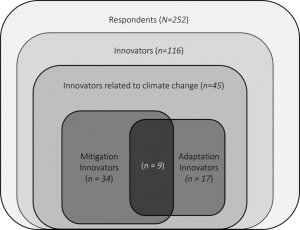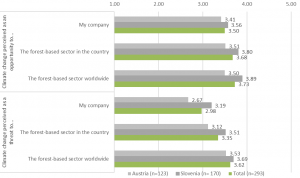
December 3, 2025

A few years ago, I wrote for this section about how innovative are Slovenian enterprises in the wood-value chain, and where is there room for improvement. Following that research, in 2021, in collaboration with the Institute of Environmental Systems Sciences at the University of Graz, we conducted a survey within the bilateral project Innovation activities of Austrian and Slovenian companies in the wood-value chain. The survey aimed to assess the environmental benefits of innovations in the forest-based sector and included both Slovenian and Austrian companies.
A total of 252 companies participated in the survey, including 170 from Slovenia and 123 from Austria. Figure 1 shows that 116 of them were innovative, but only 45 implemented innovations related to climate change. Among these, 34 were innovations aimed at climate change mitigation, while 17 focused on adaptation to climate change.

Figure 1: Number of innovations related to climate change mitigation and adaptation (Source: Slavec idr. 2023).
The conceptual model of the research was based on the Theory of Planned Behavior (Ajzen, 1991), which assumes that the individual’s behavior depends on their intention, which in turn is determined by their attitudes, subjective norms, and perceived behavioral control. Similar to previous studies that used this theoretical framework to explain environmental behavior, we confirmed the influence of attitudes, norms, and perceived control on intentions. However, intentions did not significantly affect actual behavior. Additionally, we found a direct and statistically significant influence of perceived control on behavior, but only in companies with more than 10 employees, which represent only about 10% of all companies in this sector.
To further explain behavior, we added the factor of perceiving climate change as either an opportunity or a threat, along with spatial bias in these perceptions. Previous research has shown that climate risks are perceived as a greater threat in geographically distant locations (Gifford et al., 2009). As shown in Figure 2, this also applies to Slovenian and Austrian companies, as their perception of opportunities and threats was statistically higher at the global level than at the national or company level.

Figure 2: Perceiving climate change as an opportunity or a threat (Source: Slavec idr. 2023 with an added dimension by country).
Based on these differences, we calculated spatial bias for opportunities and threats, incorporating them into the model along with the overall perception of risks and opportunities. Findings revealed that both opportunities and risks have a positive effect on supply chain adaptation (as an indicator of climate change adaptation), while spatial bias in perception has a negative effect. However, we were unable to confirm any effect on climate change mitigation.
The results of this study are presented in more detail in the article When intentions do not matter: Climate change mitigation and adaptation innovations in the Forest-based sector published in 2023 in Forest Policy and Economics (Slavec et al., 2023). The research data has been made available in the Social Science Data Archive (OPSIDP21), where other researchers can access and analyze them. Future research on this topic will continue within the project Socio-Psychological Aspects of LOng-Term High-Impact Decisions of Private Forest and Home Owners (SLOTH).
Author: Dr. Ana Slavec, InnoRenew CoE